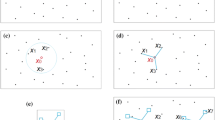Abstract
The properties of linear spatial interpolators of single realizations and trend components of regionalized variables are examined in this work. In the case of the single realization estimator explicit and exact expressions for the weighting vector and the variances of estimator and estimation error were obtained from a closed-form expression for the inverse of the Lagrangian matrix. The properties of the trend estimator followed directly from the Gauss-Markoff theorem. It was shown that the single realization estimator can be decomposed into two mutually orthogonal random functions of the data, one of which is the trend estimator. The implementation of liear spatial estimation was illustrated with three different methods, i.e., full information maximum likelihood (FIML), restricted maximum likelihood (RML), and Rao's minimum norm invariant quadratic unbiased estimation (MINQUE) for the single realization case and via generalized least squares (GLS) for the trend. The case study involved large correlation length-scale in the covariance of specific yield producing a nested covariance structure that was nearly positive semidefinite. The sensitivity of model parameters, i.e., drift and variance components (local and structured) to the correlation length-scale, choice of covariance model (i.e., exponential and spherical), and estimation method was examined. the same type of sensitivity analysis was conducted for the spatial interpolators. It is interesting that for this case study, characterized by a large correlation length-scale of about 50 mi (80 km), both parameter estimates and linear spatial interpolators were rather insensitive to the choice of covariance model and estimation method within the range of credible values obtained for the correlation length-scale, i.e., 40–60 mi (64–96 km), with alternative estimates falling within ±5% of each other.
Similar content being viewed by others
References
Agterberg, F.P. 1974: Geomathematics-Mathematical background and geoscience applications. Amsterdam: Elsevier Publish. Co.
Akaike, H. 1974: A new look at the statistical model identification. IEEE Trans. Autom. Contr. AC-19, 716–732
California Department of Water Resources. 1982: The hydrologic-economic model of the San Joaquin Valley, Bulletin 214, Sacramento, California, U.S.A.
Carrera, J.; Neuman, S.P. 1986: Estimation of aquifer parameters under transient and steady state conditions, 2. Uniqueness, Stability and solution algorithms. Water Resour. Res. 22, 228–242
Davis, J.C. 1986: Statistics and data analysis in geology, 2nd ed. New York: John Wiley
De Marsily, G. 1986. Quantitative hydrogeology. Orlando: Academic Press, Florida, U.S.A.
Delfiner, P. 1976: Linear estimation of nonstationary spatial phenomena. In: Guarascio, M.; David, M.; Huijbregts, C. (eds.). Advanced geostatistics in the mining industry, NATO-ASI, Ser, C24, Reidel, Dordrecht, The Netherlands
Gambolati, G.; Volpi, G. 1979: A conceptual deterministic analysis of the kriging technique in hydrology. Water Resour. Res. 15, 625–629
Gambolati, G.; Galeati, G. 1987: Comment on ‘Analysis of nonintrinsic spatial variability by residual kriging with application to regional groundwater levels.’ by Neuman, S.P.; Jacobson, E.A. Math. Geol. 19 249–257
Golub, G.H.; van Loan, C.F. 1983: Matrix computations. Baltimore: John Hopkins University Press, Maryland, U.S.A.
Journel, A.G.; Huijbregts, Ch.J. 1978: Mining geostatistics. London: Academic Press
Loaiciga, H.A.; Mariño, M.A. 1987: Long-term feasibility analysis of irrigated agriculture in the San Joaquin Valley, California, Procs. Intl. Symp. Water for the future: Water Resources Developments in Perspective, Vol. 2 275–283. In: Wunderlich, W.O., Prins, J.E. (eds.) Rome, Italy, April 6–11, published for the Intl. Assoc. Hydraul. Res. by Balkema, A.A., Rotterdam and Boston
Matheron, G. 1973: The intrinsic random functions and their applications. Advanced in Applied Probability 5, 439–468
Neuman, S.P.; Jacobson, E.A. 1984: Analysis of nonintrinsic spatial variability by residual kriging with applications to regional groundwater levels. Math. Geol. 16, 499–521
Patterson, H.D.; Thompson, R. 1971: Recovery of interblock information when block sizes are unequal. Biometrika, 58, 545–554
Rao, C.R. 1971: Minimum variance quadratic unbiased estimation of variance components. J. Multivariate Analysis, 1, 445–456
Rao, C.R. 1972: Estimation of variance and covariance components in linear models. J. Am. Statist. Assoc. 67, 112–115
Rao, C.R. 1973: Linear statistical inference and its applications 2nd ed., New York: John Wiley
Ripley, B.D. 1981: Spatial statistics. New York: John Wiley
Theil, H. 1971: Principles of econometrics. New York: John Wiley
Yeh, W.W.-G. 1986: Review of parameter identification procedures in groundwater hydrology. The inverse problem. Water Resour. Res. 22, 95–108
Author information
Authors and Affiliations
Rights and permissions
About this article
Cite this article
Loaiciga, H.A., Shumway, R.H. & Yeh, W.W.G. Linear spatial interpolation: Analysis with an application to San Joaquin Valley. Stochastic Hydrol Hydraul 2, 113–136 (1988). https://doi.org/10.1007/BF01543455
Accepted:
Issue Date:
DOI: https://doi.org/10.1007/BF01543455




